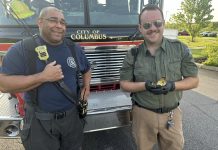Armed with shovels, jeans and long-sleeved shirts, residents of the Forest Park neighborhood spent a chilly weekend planting trees to beautify their subdivision.
Twenty-nine trees were planted in the medians of the residential area north of North Christian Church, during the Saturday-Sunday neighborhood restoration.
Although the neighborhood’s plan to plant the trees had begun last fall, the timing to plant could not have been better. Many of the trees acted as replacements for trees that died last year or were lost in a July storm that hit the subdivision hard.
This was the second tree-planting the neighborhood has conducted in 15 years, said John Armstrong, a resident of the community and a former city forester in Lafayette, who spearheaded the project.
[sc:text-divider text-divider-title=”Story continues below gallery” ]
“(Trees) die to weather-related causes,” said Armstrong, pastor at Grace Lutheran Church. “If we’re not intentional about replacing them, the forest cover disappears.”
Neighborhood residents had nearly $5,000 remaining from a $12,000 project to replace entrance pillars torn down when U.S. 31 was widened. At about $170 per tree, almost all of the remaining money was spent on the replacement trees.
Residents could choose from three types of trees.
“In Forest Park, originally you have oaks and maples, so we are planting mostly oaks, maples and some flowering crab apples,” Armstrong said. “We tried to keep it native.”
Trees were delivered Saturday, when most were planted, although some residents waited until Sunday. Some planted multiple trees, either for their own property or by helping neighbors.
Among them was Kiley Broad, who said he found the event exciting. He planted three trees — one for himself and two for others.
David and Michelle Genter, self-proclaimed tree advocates, stood outside their home on Woodland Place and watched as Wischmeier Nursery dropped off the trees. David Genter joked that the city and nursery were “doing a little too much of the work.”
The city drilled the holes, and Wischmeier Nursery placed the trees inside or right next to the holes to be planted, making planting easier.
“It helps, too, to work with a quality tree supplier,” David Genter said. “We have had a good survival rate with the trees.”
In addition to the tree restoration and pillar project, the area has a Fourth of July parade, smaller-scale picnics and a luminaria display every year on the final Sunday before Christmas, Armstrong said.
“There’s a kind of community spirit here. It begins with people who care about the neighborhood in which they live,” Armstrong said.
“There’s an effort here to maintain some kind of contact, and it’s difficult in this day and age. It’s nice to have these opportunities to work together.”
[sc:pullout-title pullout-title=”By the numbers” ][sc:pullout-text-begin]
$5,000: Amount of money used for Forest Park tree planting project
$170: Cost per tree
29: Trees planted
29: Households involved
15: Years between tree plantings in Forest Park
3: Types of trees planted
2: Days of planting
[sc:pullout-text-end]




